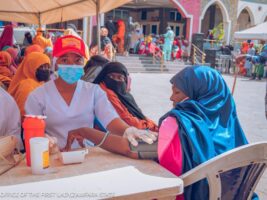The Katsina State Government has reaffirmed its commitment to tackling malnutrition through a coordinated package of health, nutrition, and food security interventions, following alarming reports on child mortality linked to the condition.
Speaking at a press briefing in Katsina, the Executive Secretary of the Katsina State Primary Health Care Agency, Dr. Shamsuddeen Yahaya, described the recent Médecins Sans Frontières (MSF) report on mortality at an inpatient treatment centre as a “wake-up call” for intensified action.
“We do not view this report negatively,” Dr. Yahaya said. “It is an urgent reminder for government, partners, and communities to unite in addressing both the immediate and underlying causes of malnutrition.”
Under Governor Malam Dikko Umaru Radda, the state has scaled up investments in nutrition. Shortly after taking office, the Governor approved ₦200 million in counterpart funding to UNICEF, unlocking an equal contribution from the agency. In 2024, another ₦300 million was allocated, again matched by UNICEF, bringing the total to ₦600 million for nutrition commodities.
Since 2016, 14 high-risk local government areas have received targeted support, with each contributing ₦250,000 monthly for outpatient therapeutic programmes (OTP). In a new agreement signed this year, all 34 LGAs will now provide ₦1 million monthly, generating ₦34 million for malnutrition response.
The state currently operates 185 OTP sites and 17 stabilisation centres, with about two-thirds run directly by the government and the rest supported by development partners.
Following Governor Radda’s July visit to the Kofar Sauri treatment centre, Katsina has developed a multi-sectoral nutrition plan with UNICEF, MSF, WFP, and other stakeholders, targeting both immediate relief and long-term prevention.



Food security measures include:
-
Distribution of farm implements for the current planting season
-
Establishment of an agricultural mechanisation centre
-
The Rumbun-Sauki initiative to improve food access
-
A taskforce to curb food hoarding and stabilise markets
Dr. Yahaya warned against the diversion or sale of Ready-to-Use Therapeutic Food (RUTF) meant for malnourished children, saying the state may introduce mobile courts and intensify public awareness to ensure proper use. He also cited high fertility rates, poor child spacing, vaccine hesitancy, and preventable diseases like measles as aggravating factors.
Dr. Umar Bello, Coordinator of the Accelerating Nutrition Results in Nigeria (ANRiN) project in Katsina, reported that over the last three years, preventive interventions have reached more than 3 million people across all 361 wards. These include:
-
Vitamin A supplementation for children
-
Micronutrient powder distribution
-
Iron and folic acid supplements for pregnant women
-
Zinc and ORS for diarrhoea treatment
Over 1,000 health workers have been trained in maternal, infant, and young child nutrition, providing counselling on breastfeeding, complementary feeding, and family planning.
Katsina will soon implement the Scaling Up Nutrition 2.0 programme, combining preventive and treatment strategies, backed by ₦700 million from Governor Radda.
Both officials stressed that all partnerships with UNICEF, MSF, WFP, and other stakeholders will continue, underscoring that addressing malnutrition remains a shared responsibility.
“Governor Radda is ready to do whatever it takes to safeguard the lives of Katsina’s people, especially our women and children,” Dr. Yahaya said.





